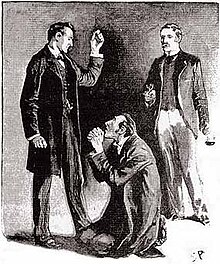The Adventure of the Blue Carbuncle
This article consists almost entirely of a plot summary. (December 2011) |
"The Adventure of the Blue Carbuncle", one of the 56 short Sherlock Holmes stories written by British author Sir Arthur Conan Doyle, is the seventh story of twelve in The Adventures of Sherlock Holmes. The story was first published in Strand Magazine in January 1892.[1]
Plot summary
Watson visits his friend Holmes at Christmas time and finds him contemplating a battered old hat, brought to him by the commissionaire Peterson after it and a Christmas goose had been dropped by a man in a scuffle with some street ruffians. Peterson takes the goose home to eat it, but comes back later with a carbuncle. His wife has found it in the bird's crop (throat). Holmes makes some interesting deductions concerning the owner of the hat from simple observations of its condition, conclusions amply confirmed when an advertisement for the owner produces the man himself: Henry Baker.
Holmes cannot resist such an intriguing mystery, and he and Watson set out across the city to determine exactly how the jewel, stolen from the Countess of Morcar during her stay at a hotel, wound up in a goose's crop. The man who dropped the goose, Mr. Henry Baker, clearly has no knowledge of the crime, but he gives Holmes valuable information, eventually leading him to the conclusive stage of his investigation, at Covent Garden. There, a salesman named Breckinridge gets angry with Holmes, complaining about all the people who have pestered him about geese sold recently to the landlord of the Alpha Inn. Clearly, someone else knows that the carbuncle was in a goose and is looking for the bird.

Holmes expects that he will have to visit the goose supplier in Brixton, but it will not be necessary: The other "pesterer" that the salesman mentioned shows up right then, a cringing little man named James Ryder whom Holmes prevails upon to tell the whole sordid story, by first mentioning that Ryder is probably looking for a goose with a black bar on its tail, a remarkable bird that "[laid] an egg after it was dead". Of course, Holmes has already deduced most of it.
Ryder, believing he was being pursued for the theft, fed the carbuncle to a goose being bred by his sister Maggie Oakshott. He was to have that goose as a gift, but lost track of which one it was.
Thus, when Ryder cut open the goose and found no gem, he went back to his sister, who had provided the Alpha Inn geese, and asked if there was more than one goose that had a black bar on its tail. She said there were two, but he was too late: she had sold them all to Breckinridge at Covent Garden. Breckinridge already sold the geese to the Alpha Inn, and the other goose with a black bar on its tail found its way to Henry Baker as his Christmas fowl. Ryder and his accomplice — the countess's maid, Catherine Cusack — contrived to disguise the crime to frame John Horner, a plumber who worked at the same hotel as Ryder and had previously been imprisoned for robbery.
Holmes, however, does not take the standard action against the man, it being Christmas, and concluding that arresting the clearly anguished Ryder will only make him into a more hardened criminal later. Ryder flees to the continent and Horner will be freed as the case against him will collapse without Ryder's perjured testimony. Holmes remarks that he is not retained by the police to remedy their deficiencies.
Media
The Granada TV version starring Jeremy Brett is faithful to the original, except that it has — after Ryder flees to the Continent — Holmes and Watson making their way to the authorities, which leads to Horner being freed in time for Christmas with his wife and children. The TV version also shows Holmes keeping the stone "in my museum" — even though Peterson has been promised the Duchess' £1,000 reward, while in the original story Holmes sends a line to the Countess saying that he has it.
Peter Cushing portrayed Sherlock Holmes in the 1968 BBC series, with The Blue Carbuncle now one of only six surviving episodes.[2]
Frank Middlemass appears in both the Granada TV version and the BBC adaptation. In the BBC adaptation he plays Peterson, whilst in the Granada adaptation he plays Henry Baker.
The 1979 Russian movie Blue Carbuncle is made in the vaudeville style, only vaguely following the original story line.
This story is also available in an altered version, but with the same characters, as part of Jim Weiss' children's CD, Sherlock Holmes for Children.
It was illustrated in a 1993 issue of Boys' Life magazine, with a few notable changes: the jewel in question is called the "Morcar Blue Diamond"; Holmes refuses Ryder's request for mercy and surrenders him to the police, although he comments that his honest admission of guilt will likely help his case for clemency; and Holmes is rewarded for returning the diamond, which he uses to set up a trust fund for a group of boys known as the 'Baker Street Irregulars', to pay for their formal education.
The animated television series Sherlock Holmes in the 22nd Century featured an adaptation of the story with the blue Carbuncle being a blue stuffed toy called "carbuncle" in the place of the goose and a Microprocessor in place of the stone.
References
- ^ "The Blue Carbuncle". Sherlockian.net. Retrieved 2011-12-27.
- ^ Stuart Douglas - www.thiswaydown.org. "Missing Episodes". Btinternet.com. Retrieved 2011-05-29.
Wikisource links
 Works related to The Adventure of the Blue Carbuncle at Wikisource
Works related to The Adventure of the Blue Carbuncle at Wikisource Media related to The Adventure of the Blue Carbuncle at Wikimedia Commons
Media related to The Adventure of the Blue Carbuncle at Wikimedia Commons
